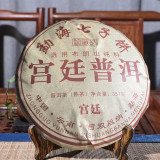Type: Loose Pu-erh
Packaging: Bag
Vintage: 90s
Process: Cooked
Rating: ★★★★★
Description:
This loose pur-erh tea is produced in Yunnan Province, China. The process in a relatively high humidity environment has mellowed the elemental character of the tea when compared to young Pu-erh (aged less 1 year). The method of production is: The tealeaves are picked, rolled, withered in the hot sun, after which they are steamed. The steaming process generates some moisture, in the course of time the tea takes on a musty and earthy character. Pu-erh that gets somewhat moldy before it naturally dries is considered the best. Pu-erh is then stored for years. As with wine, young pu-erh is considered the least valuable whereas pu-erh 5 years or older is more highly prized.
This tea is famed for its medicinal properties. The leaves come from the Yunnan Dayeh variety of tea tree - which is purported to be closely related to the original tea tree of pre-glacial times. Pu-erh is often taken for relief of indigestion and has also been reported very useful in the reduction of cholesterol. A study in Japan indicated that all tea lowered cholesterol and that pu-erh was more effective than green tea. Other followers of 'Chinese tea for health' report that pu-erh can; "cut the grease, help digestion, promote body fluid secretion, quench the thirst, invigorate the spleen and dispel alcoholic toxins" Whether pu-erh is effective or not for the various claims that researchers and tea drinkers make, has not been firmly established; but what is certain is that pu-erh is rather unusual and has properties many other teas do not share.
Pu-erh can be sorted into ten or more grades. They are royal (the highest grade), 1st, 2nd, 3rd, 4th, 5th, 6th, 7th, 8th, 9th and 10th (the lowest grade). Generally, grades are determined by leaf size and quality, lower numbered grades are made with spring buds or tender leaves, with higher numbered grades meaning older/larger, broken, or less tender leaves. Different grades have different flavors, and many bricks feature a blend of several grades chosen to balance flavors and strength. Grades 1-4 are often put into high quality tea cake and Golden Melon and grades 5-10 are often put into regular cake and brick pu-erh. However, A high grade does not always mean high quality. Some low grade loaded with stems could also make a nice cup of tea. Quality is a culmination of tea variety , processing skills, age, leaf grade, storage conditions, etc. You can see all grades in Dragon Tea House now.
Full fermented ripe tea. Stunning red liquor, good clarity, sweet, silky, woody forest taste. The aroma is distinct with an earthy undertone. The taste is smooth with a prominent initial flavor and the aftertaste is slightly sweet which lingers.
Brewing Guide: Bring freshly drawn cold water to a rolling boil. Place 1 teaspoon of tea for each cup into the teapot or gaiwan. Pour water into teapot to cover the leaves, then pour the water of - in effect you are 'rinsing' the tea. Next pour the boiling water into the teapot over the 'rinsed' leaves. Cover and let steep for 1-3 minutes according to taste (the longer the steeping time - the stronger the tea).



No related record found